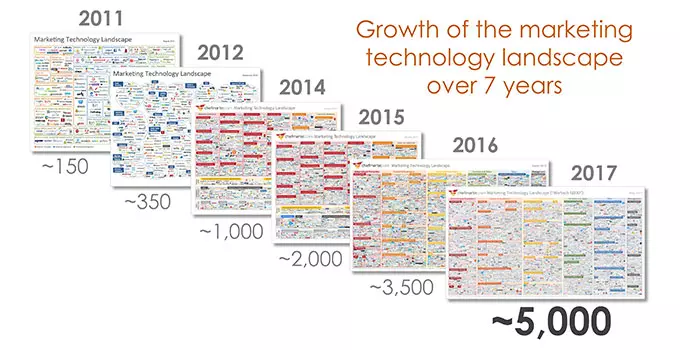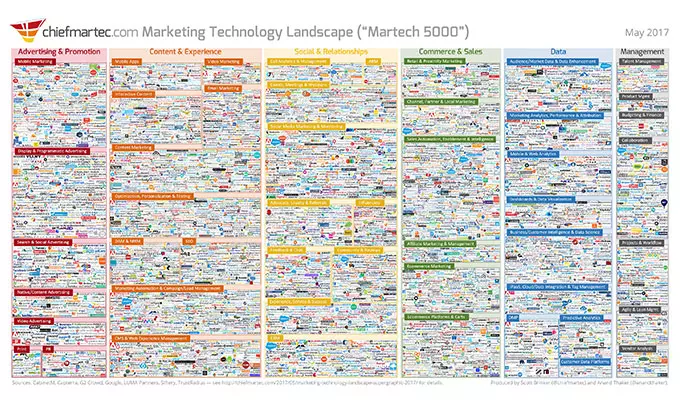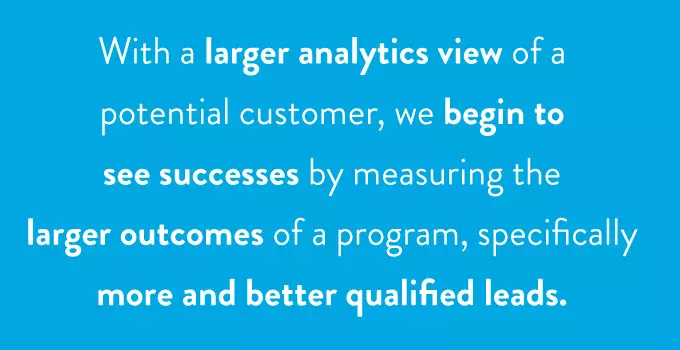Analytics, Outputs & Outcomes: New Ways Of Measuring ROI

Marketing analytics measurement is ever-changing. How do you adapt your thinking around KPIs and campaign successes to decide on what KPI’s matter to measure with so much available data?
Measurement Through Analytics, Outputs, Outcomes and a 70th Anniversary B2B Marketing Celebration
Godfrey recently celebrated its 70th anniversary as an agency, a great feat to be had and celebrate! In our atrium we have an open space where the fourth floor has an overhang. Along the railing, a timeline of Godfrey’s history hung, along with some major technological changes that affected B2B marketing during that time.
Looking at the last 10 years made me laugh, remembering the early days of Google Analytics, AdWords and Facebook. At the time, we looked at this new analytics data with amazement. We weren’t sure what to do with it or how we were going to show ROI in our marketing campaigns, but we were determined to prove it!

SOURCE
Two things have happened since: First, we have a lot more data available at our fingertips via new software. Second, we are still confused about analytics when talking about measurement: what to measure when determining success via outputs (immediate incremental KPIs) and outcomes (the ultimate goal of a campaign, like better qualified leads). In marketing programs and measuring ROI, both are important, especially when looking at measuring in a longer B2B Sales cycle.
Much of this confusion seems to stem from the growth of technology in general and its ability to further track users across the customer journey. Some of it, though, comes from several other factors that I’ll get into below.
The proliferation of analytics tracking makes it tough to decide what to measure.
Today we expect a lot out of our online experiences. With technology has come an expectation that we as users will get the relevant information we want in a timely fashion. As marketers, we utilize a variety of technology, including marketing automation and personalization software. With it, though, we continue to add layers of analytics tracking and a potentially false sense of security that we will have the analytics needed to tell a full ROI story.

SOURCE
Making decisions on measurement at the outset of a campaign is paramount.
With seemingly endless data sources, it’s even more important than ever to decide your KPIs and subsequent measurement at the beginning of a campaign. This helps to have a common framework to start from when creating the rest of the campaign and helps to maintain focus, especially when other technologies are involved. Furthermore, it ensures that we can accurately measure our campaign for success and optimization. It doesn’t allow for an intrusion of last minute ideas for measurement to be added as all of a sudden deemed necessary when they may not.
Automation and personalization have changed what we measure to more of an outcome-based environment.
As mentioned earlier, new technologies used to enable customized customer journeys are changing how we look at analytics and measurement. Instead of measuring if someone downloaded a white paper or signed up for an e-news, we begin to look at the person in general and notice the actions and micro conversions they make on a site to become a more qualified person in our CRM database. With a larger analytics view of a potential customer, we begin to see successes by measuring the larger outcomes of a program, specifically more and better qualified leads. Furthermore, these leads have a history that can be leveraged by sales to create a more personalized conversation of business needs, saving time and money.

We need to continue to think about our analytic measurement, specifically outcomes and outputs, as part of our campaigns. Here’s how.
As technology continues to change our thinking about campaign measurement, defining and measuring the outcome of a campaign is key.
- Define the outcome by thinking about the next step after the campaign ends. If a sales manager is hoping for leads to be driven to them from a campaign, what do they want out of it to make their job easier? Better qualified leads.
- Define the outputs, or incremental indicators of success during a campaign. Everything a user does on a website helps to score and prioritize them as leads so they are more informed and better educated when talking to sales. Accurately defining outputs helps prioritize those indicators of success so you can adjust your lead scoring accordingly. This will, in turn, better score leads for sales.
- Confirm that what have been defined as outputs and outcomes align with the KPIs of your marketing plan. Make sure all campaign stakeholders agree with what is being measured. Furthermore, confirm outputs can be easily measured with the implemented technology.
- Look for small, incremental opportunities to optimize from your campaign measurement.
At the end of the day, looking back on those 10 years, we as marketers are smarter today. Technology has made us be honest with our marketing, accurately measuring our campaign successes and failures. Its this availability of data and precision of measurement that holds us to a higher standard. This is seen in an analytics measurement sense as well as how we think about the customer journey and serving up relevant, personalized content at the right time.
Sign Up for our Newsletter - Get agency updates, industry trends and valuable resources delivered directly to you.
Godfrey Team
Godfrey helps complex B2B industries tell their stories in ways that delight their customers.




